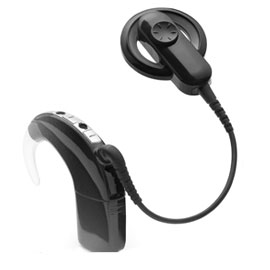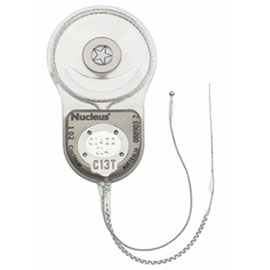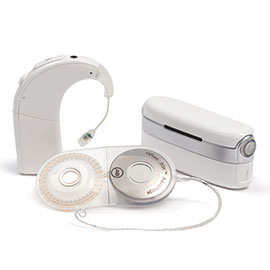Early intervention refers to the multi-disciplinary coordinated services that a child with hearing loss and his/her family should receive for listening, learning, talking and in other areas of development. Intervention for hearing loss should begin as early as possible or as soon as a diagnosis of hearing loss is made, so that a child can enjoy the maximum possible benefit and the best possible outcomes.
A child can learn spoken language only if he/she can hear well. The earlier a baby starts to listen and the earlier there is language in the baby's environment; the sooner listening, language and speech can develop. In the case of children the first 2-3 years of life are critical for speech and language development.
Although babies with hearing loss do not have the same auditory input as babies with good hearing capacity, their brains are well-equipped to learn spoken language. Early aiding can help them to be at par with their typical (normal) hearing peers. Hence it is important that their hearing is aided as early as possible. The Joint Committee on Infant Hearing (JCIH), which comprises of a team of health professionals, recommends a 1-3-6 protocol. This means that hearing screening should be completed by 1 month of age, hearing loss diagnosed by 3 months of age and intervention be no later than 6 months.
In the case of older children or adults with a severe to profound sensorineural hearing loss, it is important that they receive intervention as early as possible.
Intervention in cases of sensorineural hearing loss can be done with the help of hearing aids, or in cases with severe to profound sensorineural hearing loss, where even optimally fitted hearing aids do not help - with a cochlear implant.
HEARING AIDS
A child can be fitted with a hearing aid at any time – even soon after birth. Hearing aids should be fitted based on the degree of the child’s hearing loss.
A battery of audiological tests are required before an appropriate hearing aids are fitted. The fitting cannot be based only on an ABR (BERA) report. Tests such as a Behavioural Observation Audiometry (BOA) can help in proper fitting of hearing aids depending on responses given by the baby at different sound frequencies.
Once hearing aids are fitted, the child’s responses with the hearing aids are tested. This helps the audiologist to assess whether the child is adequately benefitted by the hearing aid. The child is given a trial of hearing aids in both ears, usually for 2-3 months. In adults too, a hearing test is done before and after fitting of hearing aids to check the benefit with hearing aids (Unaided and Aided audiograms). Additional tests such as a Speech discrimination score with hearing aids (tested separately for each ear) are also required. If the hearing aids do not provide adequate benefit, the individual may be a candidate for a cochlear implant. The duration of hearing aid trial may be shorter if a cochlear implant has to be done at the earliest, as in cases of meningitis with cochlear ossification where a delay may result in obliteration of the cochlear lumen.
Hearing aids cannot reverse or stop the hearing loss from worsening- they make the sound louder, and thus aid in hearing better. Hearing aids require a battery. The basic components of a hearing aid are a microphone - which picks up the sound, an amplifier – which makes the sound louder, and sends it to the receiver, which further sends it to the ear.
Hearing aids may be BTE (Behind the ear), ITC (In the canal) or CIC (Completely in the Canal). The type of hearing aid that is required depends on the degree and the pattern of hearing loss, physical limitations, medical conditions, personal preference and affordability of the patient. For example, a BTE hearing aid may be preferable in babies, young children and elderly individuals, as handling and manipulation of the controls is easier. More powerful hearing aids may be required if the hearing loss is more severe.
Bone conduction hearing aids may be recommended in children with a conductive hearing loss with malformed outer or middle ears.
Although using a hearing aid DOES NOT stop the natural worsening of hearing loss, not using a hearing aid for prolonged periods can lead to lack of auditory stimulation to the part of the brain responsible for hearing. Over a period of time, the function of this part of the brain is gradually taken over by the visual cortex (part of the brain responsible for vision), so that the individual starts to use visual cues more than hearing to communicate. This reduces the benefit that can be obtained from a hearing aid or a cochlear implant done later.
COCHLEAR IMPLANTS
 Cochlear implant is a surgically implanted electronic device in individuals with severe to profound sensorineural hearing loss, who get no significant benefit with optimally fitted hearing aids. A cochlear implant performs the function of the damaged portion of the inner ear (cochlea), and delivers electrical signals to the ganglion cells close to the auditory (hearing) nerve. The auditory nerve relays these signals to the brain, which interprets them, and sound is perceived.
Cochlear implant is a surgically implanted electronic device in individuals with severe to profound sensorineural hearing loss, who get no significant benefit with optimally fitted hearing aids. A cochlear implant performs the function of the damaged portion of the inner ear (cochlea), and delivers electrical signals to the ganglion cells close to the auditory (hearing) nerve. The auditory nerve relays these signals to the brain, which interprets them, and sound is perceived.
The device has an external component (a microphone, a speech processor and a transmitting coil), which sits behind the ear; and an internal component (the receiver-stimulator and the electrode array), which is surgically implanted under the scalp behind the ear, with an electrode array that sits around the auditory nerve within the cochlea. Both parts work together to allow the user to perceive sound.
Who can benefit from a cochlear implant?
Candidacy depends on a number of factors which are collectively taken into account by the cochlear implant team. Factors such as onset of hearing loss, duration of hearing loss, hearing history, cause of hearing loss, degree of residual hearing, etc., play an important role. When an individual has little or no benefit with optimally fitted hearing aids, he / she may be a candidate for a cochlear implant.
Congenitally hearing impaired children should be implanted as early as possible. The first three years of life are critical for the development of speech and language, and hence younger the age at which a child is implanted, the better are the results. Even children below the age of 1 year have been successfully implanted.
There is no upper age limit for undergoing a cochlear implant in the post-lingual group of patients, provided there are no medical or surgical contraindications, and the other criteria for a cochlear implant are met with. Older children or adults who have well developed speech, but have lost hearing following an episode of meningitis, or have had progressive deterioration of hearing due to other causes, may also be candidates for cochlear implantation.
What tests are required before surgery?
 A complete audiological evaluation and an adequate hearing aid trial, and initiating habilitation pre-operatively is a must before a cochlear implant surgery is performed. Equally important is imaging with CT scan and MRI. The duration for hearing aid trial may be relaxed in cases such as cochlear ossification where surgery should be performed as early as possible. Certain pre-operative blood investigations are also required. In addition to this, children also need certain vaccinations pre-operatively.
A complete audiological evaluation and an adequate hearing aid trial, and initiating habilitation pre-operatively is a must before a cochlear implant surgery is performed. Equally important is imaging with CT scan and MRI. The duration for hearing aid trial may be relaxed in cases such as cochlear ossification where surgery should be performed as early as possible. Certain pre-operative blood investigations are also required. In addition to this, children also need certain vaccinations pre-operatively.
What does a cochlear implant surgery involve?
The surgery is performed under general anaesthesia. An incision is made behind the ear to be implanted. The internal component of the implant is secured on the bone under the scalp. The electrode array is inserted inside the cochlea by drilling a small opening into the cochlea, or through the round window of the cochlea.
The patient is discharged within 24 hours after the surgery. The device is ‘switched-on” about 2 weeks following surgery and mapping and habilitation is started.
Where can I go to get a cochlear implant?
 A special clinic for individuals with hearing loss (babies, children and adults) is run at Hinduja Hospital by Dr. Milind Kirtane and his team, every week on Tuesdays, between 2-4pm. The team evaluates each patient regarding candidacy and guides them through the pre implantation procedures.
A special clinic for individuals with hearing loss (babies, children and adults) is run at Hinduja Hospital by Dr. Milind Kirtane and his team, every week on Tuesdays, between 2-4pm. The team evaluates each patient regarding candidacy and guides them through the pre implantation procedures.
All necessary investigations such as OAE, BERA, ASSR, radiological investigations (CT scans and MRI) etc. are done by a panel of clinicians with special experience and expertise in the field of cochlear implants. An in-house paediatrician evaluates each patient thoroughly prior to surgery.
